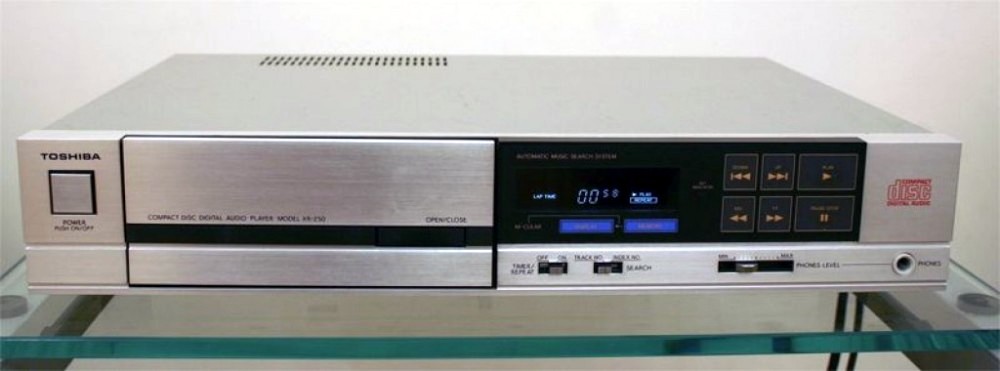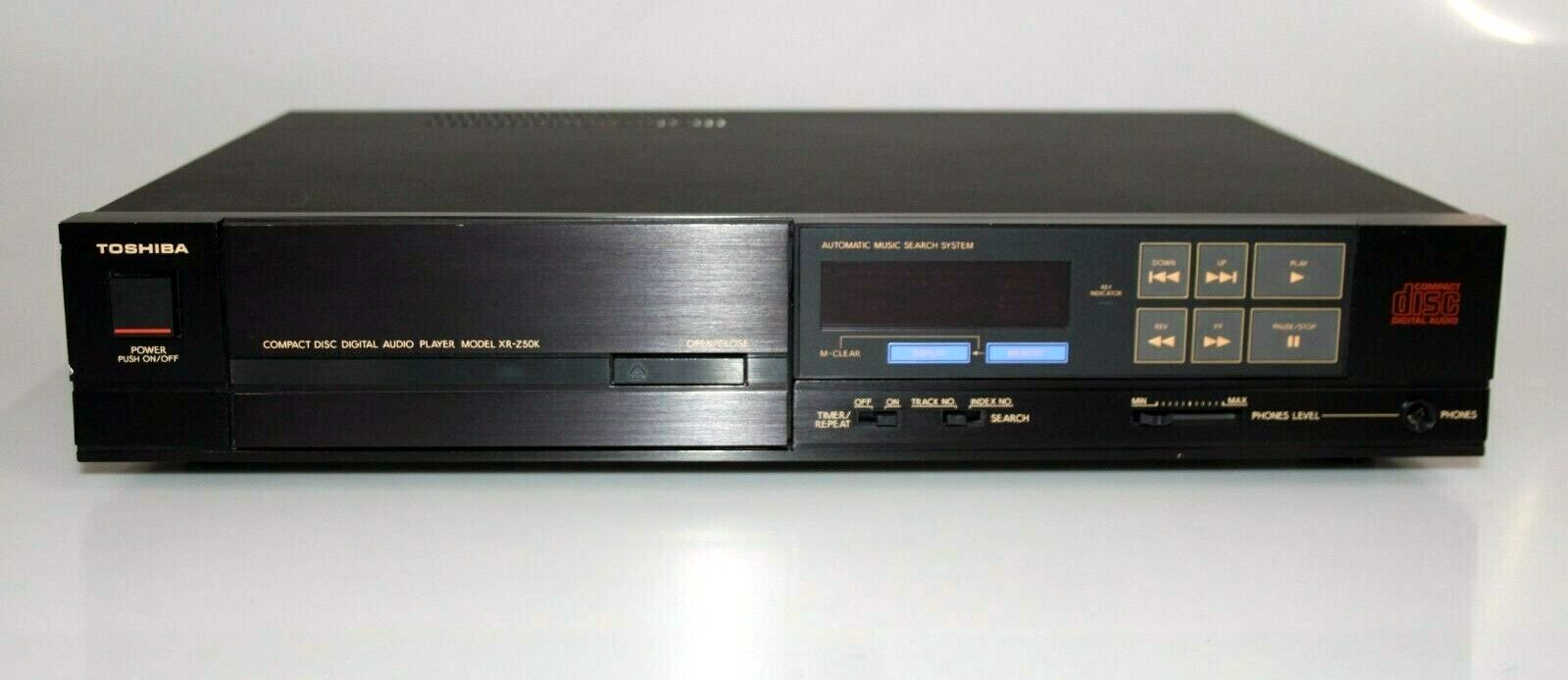Difference between revisions of "Toshiba XR-Z 50"
| (3 intermediate revisions by the same user not shown) | |||
| Line 1: | Line 1: | ||
__NOTOC__ | __NOTOC__ | ||
| − | == | + | == Data == |
| − | {{ | + | {{navigation}} |
| − | ''' | + | '''General''' |
| − | * | + | * Manufacturer: [[Toshiba]] |
| − | * | + | * Model: XR-Z 50 |
| − | * | + | * Type: CD-Player |
| − | * | + | * Years of manufacture: 1984 - 1986 |
| − | * | + | * Made in: Japan |
| − | * | + | * Color: Silver, Black |
| − | * | + | * Dimensions: 420 x 85 x 309 mm (WxHxD) |
| − | * | + | * Weight: 5.3 kg |
| − | * | + | * Original price approx.: 1'050 DM, 1984 |
| − | ''' | + | '''Connections''' |
| + | * Number of inputs: | ||
| + | ** - | ||
| + | * Number of outputs: | ||
| + | ** Analog (Cinch): 2 V | ||
| + | ** Headphones (jack) | ||
| − | |||
| + | '''''Technical data'' | ||
| + | * Transducer: | ||
| + | * Frequency response: 5 Hz - 20 kHz | ||
| + | * Dynamic range: > 96 dB | ||
| + | * Signal-to-noise ratio: > 96 dB | ||
| + | * Distortion factor: 0,003 % * Channel separation: > 90 dB | ||
| + | * Channel separation: > 90 dB | ||
| + | * CD-Text: no | ||
| + | * MP3 support: | ||
| + | * Pitch control: | ||
| + | * Auto play: | ||
| + | * Shuffle: | ||
| + | * Title programming: | ||
| + | * Repeat: | ||
| + | * Plays CD-R/CD-RW/HDCD: | ||
| − | == | + | |
| − | * | + | '''Special Features''' |
| + | * Headphone output adjustable | ||
| + | |||
| + | |||
| + | == Remarks == | ||
| + | * Other models in the same series: | ||
* [[Toshiba XR-Z 50]] | * [[Toshiba XR-Z 50]] | ||
* [[Toshiba XR-Z 60]] | * [[Toshiba XR-Z 60]] | ||
| Line 27: | Line 51: | ||
| − | == | + | == Pictures == |
| − | * | + | * [[Picture: Toshiba XR-Z 50 in silver |
| − | [[ | + | [[File:Toshiba XR-Z 50-1984.jpg]] |
| + | |||
| + | |||
| + | * Picture: Toshiba XR-Z 50 in black | ||
| + | [[File:Toshiba XR-Z 50-1.jpg]] | ||
| − | == | + | == Reports == |
| − | * | + | * Report at "Hifi-Museum": |
* Toshiba XR-Z 50 | * Toshiba XR-Z 50 | ||
| − | * | + | * The latest drawer from Toshiba has turned out pleasantly flat. Measured by the low price, the XR-Z 50 offers quite a bit of access. By pressing a button, the scanning head jumps to the next or previous title, pressing several times causes correspondingly larger jumps. After pressing a slide switch, indices can be selected in the same way. |
| − | + | A fast forward and rewind function is also available, but without the possibility to listen in. However, the display is automatically switched to title time display for the time of the search process, so that at least a visual control is available. | |
| − | + | Problems with soiling when inserting the disc are as good as impossible, because the drawer extends pleasantly far. | |
| − | + | A special position opposite its competitors takes the small Toshiba regarding its programming kind. It is not possible to combine different titles in any order and frequency to a program. Only a coherent block can be selected and, if desired, played several times with the help of the "Repeat" function. Such a block is not bound to the beginning or the end of titles, but can also be arbitrarily limited by time stamps. Unlike other devices, however, this feature hardly deserves the name "programming". | |
| − | * | + | * The display fulfils its function quite well, but the simultaneous display of title/index and real time/remaining time has to be done without. Switching is possible. The operation is done via short-travel keys, which sit behind a tough plastic foil. Ladies with long fingernails might have problems here. |
| − | + | Excellent price/value ratio | |
| − | + | There is nothing to criticize about the transmission characteristics of the XR-Z 50, they are consistently top class. The noise immunity is also impressive, press faults and surface contamination leave it cold. If the unit is placed on a surface with a reasonably low level of vibration, there will be no playback interference. Praiseworthy is the adjustable headphone output, which can elicit quite a bit of volume from relatively quiet listeners. | |
| − | + | All in all, Toshiba's XR-Z 50 is a highly recommendable device, which does without the really big refinements in terms of ease of use, but can come up with good data and an extremely low price. rp | |
| Line 54: | Line 82: | ||
| − | [[ | + | [[Category:CD Player]] |
Latest revision as of 08:28, 10 April 2020
Data
General
- Manufacturer: Toshiba
- Model: XR-Z 50
- Type: CD-Player
- Years of manufacture: 1984 - 1986
- Made in: Japan
- Color: Silver, Black
- Dimensions: 420 x 85 x 309 mm (WxHxD)
- Weight: 5.3 kg
- Original price approx.: 1'050 DM, 1984
Connections
- Number of inputs:
- -
- Number of outputs:
- Analog (Cinch): 2 V
- Headphones (jack)
Technical data
- Transducer:
- Frequency response: 5 Hz - 20 kHz
- Dynamic range: > 96 dB
- Signal-to-noise ratio: > 96 dB
- Distortion factor: 0,003 % * Channel separation: > 90 dB
- Channel separation: > 90 dB
- CD-Text: no
- MP3 support:
- Pitch control:
- Auto play:
- Shuffle:
- Title programming:
- Repeat:
- Plays CD-R/CD-RW/HDCD:
Special Features
- Headphone output adjustable
Remarks
- Other models in the same series:
- Toshiba XR-Z 50
- Toshiba XR-Z 60
- Toshiba XR-Z 70
- Toshiba XR-Z 90
Pictures
- [[Picture: Toshiba XR-Z 50 in silver
- Picture: Toshiba XR-Z 50 in black
Reports
- Report at "Hifi-Museum":
- Toshiba XR-Z 50
- The latest drawer from Toshiba has turned out pleasantly flat. Measured by the low price, the XR-Z 50 offers quite a bit of access. By pressing a button, the scanning head jumps to the next or previous title, pressing several times causes correspondingly larger jumps. After pressing a slide switch, indices can be selected in the same way.
A fast forward and rewind function is also available, but without the possibility to listen in. However, the display is automatically switched to title time display for the time of the search process, so that at least a visual control is available.
Problems with soiling when inserting the disc are as good as impossible, because the drawer extends pleasantly far.
A special position opposite its competitors takes the small Toshiba regarding its programming kind. It is not possible to combine different titles in any order and frequency to a program. Only a coherent block can be selected and, if desired, played several times with the help of the "Repeat" function. Such a block is not bound to the beginning or the end of titles, but can also be arbitrarily limited by time stamps. Unlike other devices, however, this feature hardly deserves the name "programming".
- The display fulfils its function quite well, but the simultaneous display of title/index and real time/remaining time has to be done without. Switching is possible. The operation is done via short-travel keys, which sit behind a tough plastic foil. Ladies with long fingernails might have problems here.
Excellent price/value ratio There is nothing to criticize about the transmission characteristics of the XR-Z 50, they are consistently top class. The noise immunity is also impressive, press faults and surface contamination leave it cold. If the unit is placed on a surface with a reasonably low level of vibration, there will be no playback interference. Praiseworthy is the adjustable headphone output, which can elicit quite a bit of volume from relatively quiet listeners.
All in all, Toshiba's XR-Z 50 is a highly recommendable device, which does without the really big refinements in terms of ease of use, but can come up with good data and an extremely low price. rp

